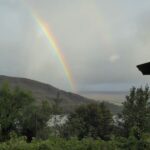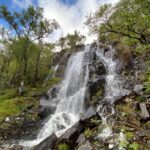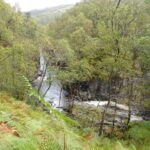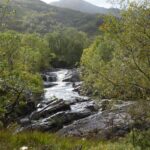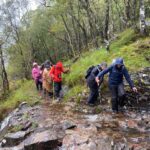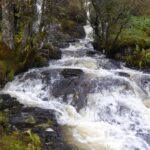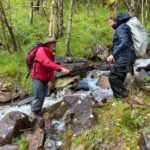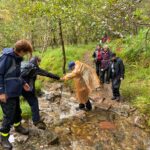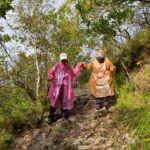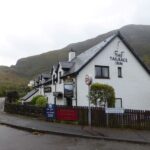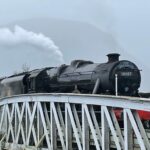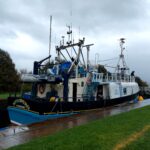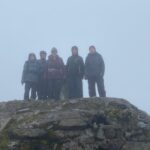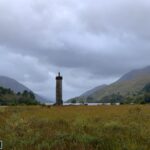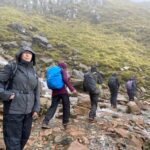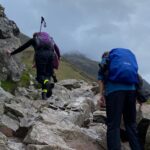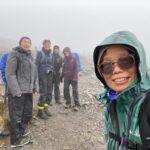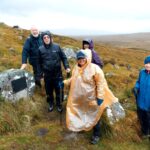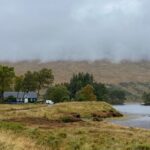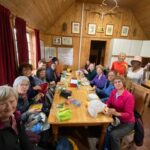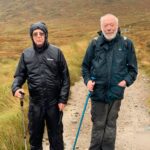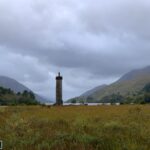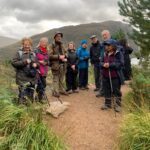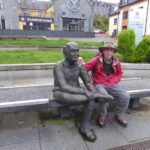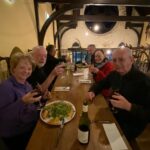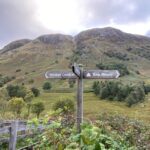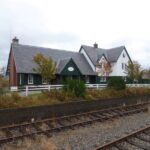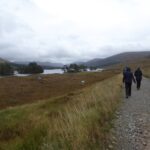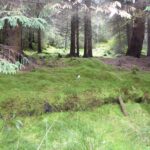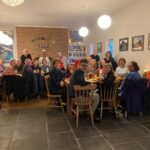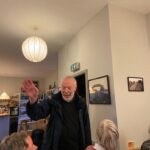By some lovely twist of fate, I spent seven weeks of the first lockdown in 2020 marooned in youth hostel at Loch Ossian in Corrour, where my friend is the manager. During my sojourn I grew to appreciate what a special place it was wanted to share it with my fellow Polyramblers, hence the idea for this trip was born. The facilities in the Loch Ossian hostel are rudimentary and not to everyone’s taste, so it was decided to base the weekend in Fort William, with access to a variety of hiking and sightseeing options, not least Ben Nevis and to culminate with a day in Corrour.
My thanks to all contributors to this report and especially Sandy and Danny for leading the strollers and helping with the overall planning.
Twenty four Poly Ramblers met at Glasgow Central station on Friday 30th September to travel up to Fort William. About half of them had arrived the day before, without event, and spent a morning exploring Glasgow. The remainder valiantly weathered the last minute scheduling changes – complete with buggy transfer to the train to secure seats en-masse – and delights of en-route delays to finally arrive 90 minutes late. Fortunately there was a private coach booked for the remainder of the journey and the driver was not only patient and helpful, he provided an interesting and entertaining commentary along the route. The group finally arrived in Fort William at 7.00pm. The group was joined by two other members the next day who had travelled independently.
Saturday 1st October: Hikers Walk – Kinlochleven Circular
Eighteen hikers took the 10.30 bus from Fort William to Kinlochleven. The intention had been to walk up Glen Leven through trees and streams to reach the Blackwater Dam and across the bottom of the dam back down on a wide path to Kinlochleven in time for the 6.30 pm bus back. We climbed up the valley on a narrow rocky path, levelling out at one point to a more grassy area which had been a WWI POW camp with a few small stumpy ruins. Views were initially of waterfalls through the trees on the other side of the steep valley walls. However, what had been a few gentle rocky streams when I did the recce in June had been swollen by recent heavy rain had become much deeper and more challenging, requiring helping hands and walking poles along the way with a few falling in and getting quite damp! The going was slow but at least it wasn’t raining. But fortunes were against us and after about two and a half hours we reached a fast cascading waterfall which was impassable, so we stopped for lunch and admired the views. There was no alternative but to head back the way we had come and although a little trepidatious of recrossing the streams proved less difficult this time. We arrived back in Kinlochleven at about 4:30 pm and passed the next couple of hours very pleasantly in the very welcoming Balcony Bar of the Highland Getaway Inn, drying out our boots and socks and admiring the views.
If we had managed to complete the planned walk we would have discovered that the Blackwater Dam was built in 1904 and was the first Hydroelectric dam in the UK, constructed to support the new Aluminium smelting industry in Kinlochleven.
On return to Fort William hikers went their separate ways for dinner and a few of us met up with the strollers in the Ben Nevis pub.
Strollers walk to Spean Bridge and the Commandos Memorial – report by Sandy
Just five Strollers caught the bus at the Fort William bus station for the 35 minute journey to Spean Bridge, with a detour to the ski centre. Spean Bridge is at the junction of the A82 to Inverness and the A86 to Newtonmore and the A9. The first stage of our walk took us up the busy A82 for about a mile to reach the Commando Memorial; fortunately there was a pavement all the way.
The Commando Memorial is dedicated to the men of the original British Commando Forces raised during World War II. This site was chosen because it is on the route to the commandos’ nearby training base at Achnacarry Castle. A further reason for the choice of site is that it provides a good view of Ben Nevis and Aonach Mor. The cloud denied us that view but I think I just about made out the vague outline of the Ben. Near the memorial is a garden of remembrance which contains plaques with the names of commandos who served in World War II. There are also plaques with the names of members of the armed forces who died in more recent conflicts. We were saddened to see that so many of them were 23 and 24 year olds.
Our route back to Spean Bridge took us first on a well-kept path over moorland and then along a disused railway line high above the River Spean. The guide book says that part of the trail follows General Wade’s military road. I failed to spot this but we did see the ruins of the High Bridge, built by General Wade. General Wade built roads in the Highlands for use by the army which occupied the area after the Jacobite rebellion in 1745. The first skirmish in that conflict took place near Spean Bridge.
We arrived back in Spean Bridge in time for lunch, after stopping to chat with a lady and her lively young dog. We had lunch in the Bridge Café, which was run by a lady who might have been a sergeant major in the army, such was her manner in telling people where to sit and giving orders to the young girls who were serving. However, to her credit she pointed out to me that my return bus ticket had fallen out of my wallet when I was paying my bill.
It had been raining on and off all morning and three of the group decided to return to Fort William to look round the town. Two of us set off across the railway line for an invigorating walk in Killiechonate Forest. At times the rain was quite heavy but we enjoyed the way the path twisted and turned and went up and down. When we returned from the walk we visited another café with a souvenir shop where we passed the time till we caught the 16.22 bus, which we nearly missed. The day was rounded off with a meal in the excellent Ben Nevis pub, where we were joined by three of the Hikers.
Sunday 2nd October: Small group Hikers ascent of Ben Nevis – report by Jo
Carole, Mary, Dominique, Ida and Jo formed the Ben Nevis breakaway group. We set off from Glen Nevis youth hostel and took the steep direct route up to the main path, where we met quite a few ‘3 peakers’ on the way down from the summit and many more parties on their way up the so called Tourist Path.
Our ascent took 4.5 hours, the last part through swirling mists as we navigated the pink granite boulders into the tundra – with regular updates from Dominique’s ‘metres climbed’ app to encourage us. Despite a few mishaps at the summit everyone made it down in one piece, in good spirits and in a sedate 5 hours or so, with some lovely views once we’d cleared the zig zag paths.
Hikers – Glen Nevis and the Polldubh Falls
Thirteen hikers met at the Glen Nevis Visitor Centre walk along the glen. In good weather this is a lovely circular walk of 8 miles along the river Nevis to the lower falls at Polldubh. This plan was reviewed in light of the previous day’s adventures and wary of the impact of the rain and on recommendation from one of the staff at the youth hostel, it was decided to only walk the higher level path to avoid being ‘knee deep’ in bog!
The walk was pleasant on a wide path and we reached the falls easily, glancing up at the cloud on the summit of Ben Nevis from time to time wondering how the Intrepid five were managing!.
After picnicking at the falls we retraced our steps about halfway along the path and then ascended to Cow Hill. The track was wide but very steep and three of us stopped just before the summit and returned back down to our accommodation at the Glen Nevis Youth Hostel and the remaining eight persevered and were rewarded by lovely views over Loch Linnhe, before following the path back down to Fort William in time to have a break before dinner.
Strollers – Neptune’s Ladder and Glenfinnan report by Sandy
On Sunday 9 Strollers caught the bus in Fort William for the short ride to Banavie. We arrived in Banavie in time to see the Jacobite steam train on its way to Mallaig. The train was hauled by a Stanier Black Five 4-6-0 locomotive “The Lancashire Fusilier”. On the way to Mallaig the train crosses the Glenfinnan Viaduct, which is connected with someone called Harry Potter, but more about Glenfinnan later. At Banavie we visited Neptune’s Staircase. This is a series of 8 locks on the Caledonian Canal; they are known as ladder locks because each one leads into the next one, and are operated hydraulically, with electronic controls. We spoke to one of the lockkeepers who told us that a boat was about to come through the locks. This boat was a sort of floating B&B called the Nova Spero, and I think it would have been too big for the Grand Union Canal.
After seeing the Nova Spero go through the locks we walked along the bank of the Caledonian Canal to Corpach. Corpach marks the end of the Caledonian Canal, the other end being at Inverness. Corpach is only a small place but we did find a Co-Op which had a coffee machine. From Corpach we caught the regular diesel service along the shore of Loch Eil to Glenfinnan. At Glenfinnan we first visited the small museum at the station which contained some interesting railway memorabilia and pictures. The station is some distance from the famous Glenfinnan Viaduct and we followed a tourist trail to reach it. This proved to be the most challenging part of the Strollers’ walks and poles proved to be very useful. Fortunately it stayed dry for that part of the day.
The Glenfinnan Viaduct was always a popular tourist destination but has become even more famous in recent years because of its connection with Harry Potter. Two features that make it special are its setting near the head of Loch Shiel and the fact that is curved, unlike Ribblehead which is longer but straighter. Coming down from the tricky path we passed under the viaduct and went past a car park. At that point I had to point out to our leader that there was another historical monument to see. This was the monument to Bonnie Prince Charlie at the head of Loch Shiel. Prince Charles Edward Stuart was the grandson of James II and raised his standard before 700 clansmen at Glenfinnan to start his journey to Edinburgh, Derby and Culloden. He has become a romantic figure and his monument is in a romantic setting at the head of Loch Shiel.
After visiting the monument and admiring the view down Loch Shiel we returned to Glenfinnan station to wait for the train to take us back to Fort William. Again, this was a diesel multiple unit, not the famous Jacobite. On the subject of trains, I think it worth pointing out that the locomotive used in the Harry Potter film was not The Lancashire Fusilier but a GWR Hall class 4-6-0 locomotive, named Olton Hall. Those of you who are train enthusiasts, and I know there are some, can see this locomotive as it is on display in the Warner Brothers studio.
Most of the group then met for dinner at the Black Isles Bar, which specialises in craft beer, whisky and pizza!
Monday 3rd October – A Day in Corrour
The whole group met at Fort William Train Station to catch the 11.40 train to Corrour – the most remote and highest stop on the UK rail network. It is also a stop on the Caledonian sleeper overnight to and from London. The station was built as a condition, stipulated by the then Laird, of running the Glasgow to Fort William railway line through the Corrour Estate. This is very fortuitous for hikers and lovers of the Scottish countryside as it provides access to a very beautiful area on the edge of Rannoch Moor and the small but picturesque Loch Ossian.
On arrival we were met by Jan the manager of the Loch Ossian youth hostel. We had a brief comfort break in the Station House restaurant (more of which later) and walked down the 1.6 km track down to the Youth Hostel which is sited on the edge of the Loch. Despite the drizzle and mist as we reached the top of the loch the view of the mountains was magical.
Loch Ossian Youth Hostel has an interesting history as the building was the former timber-clad boathouse and stables built c.1895 at the western end of Loch Ossian by Sir John Stirling Maxwell (1866 – 1956), owner of the Corrour Estate, to wait for his steam yacht which would carry him and his guests along the loch to Corrour Lodge. The stables kept a pony to pull a trap from Corrour Railway Station, a mile (1.6 km) to the west, to the boathouse. The property was given by Stirling Maxwell, a great environmentalist and supporter of access to countryside, for use as a Youth Hostel in 1931, one of the very first run by the Scottish Youth Hostels Association. It now comprises an eco-hostel, with shared dormitories and electricity is provided by a wind turbine. Composting toilets are provided and a reed bed is used to soak away grey water.
We stopped at the hostel to have our lunch and were treated to hot drinks and Jan’s homemade banana bread. Some of us sat inside warmed by the woodburning stove and some stayed out by the picnic tables to admire the views across the loch.
Due to the mist, the group unanimously agreed not to attempt any hills and most opted for part or all of the 8-mile circuit of Loch Ossian. walk is flat on a good path in forestry in places, but with good mountain views and a chance to view modern Corrour Lodge at the far end of the loch. A few of us climbed up a little way to Peter’s Rock which is a memorial to Peter Trowell an ex-warden of the youth hostel who sadly drowned in the loch in the winter of 1979 and his body was found only when the Loch unfroze some weeks later. The memorial plaque on the rock reads:
I have a friend a song and a glass
Gaily along life’s road I pass
Joyous and free out of doors for me
Over the hills in the morning.
Not a bad epitaph!
We then convened for dinner in the lovely Station House Restaurant. This welcoming bar and eatery provides snacks and meals and good cheer to all visitors and hosted the whole group with aplomb. The food was delicious and plentiful and we chatted and played games by the fire.
Sadly, Danny could not stay for long as his sleeper train was cancelled due to an electrical fault and he had to get the earlier train to Glasgow instead. The rest of us also experienced the realities of remote Scottish railways in that our return train to Fort William was delayed due to bad weather and we spent a good while sheltering from the rain on the platform, hoping we were not going to be stranded. Fortunately, Jan had called her friend in the next station down the line and who confirmed that the train was indeed on its way sat in the van on the other side of the platform on lookout and flashed her lights as soon as she saw it rounding the hill.
Some comments from Sandy who led the strollers
As the whole group went to Corrour and some of the Hikers went to Peter’s Rock, I will confine myself to a few personal observations, as I assume the visit was reported elsewhere. When we arrived at the youth hostel the weather was not too bad and some of us were able to enjoy a picnic outside while looking down Loch Ossian towards the misty mountains. These mountains include Ben Alder, described in my Munros’ guide as “one of the great remote mountains of Scotland”. Jan the warden pointed it out to me and I think I could just make out its outline. I was impressed to learn that Jan has climbed Ben Alder. A small group of Strollers set off to climb up to Peter’s Rock and were encouraged by the Hikers we met on their way down from the rock as they told us we didn’t have far to go. It was a fairly easy climb up to Peter’s Rock, but a bit wet. Back at the hostel we tried to dry out a bit before returning to Corrour station for our meal. During my excellent meal I enjoyed the attentions of the black labrador who was waiting for me to drop some chips on the floor. Needless to say I didn’t, at least not deliberately. My final memory of Corrour was of our wait for the train, all crowded into the shelter, out of the rain.
A word about Gaelic names.
The ben in Ben Nevis is an English version of the Gaelic word beinn, where the ei is pronounced like the ay in day, and of course it means mountain. There is a word ben in Gaelic, it is spelt bean and means woman. The plural is mnathan, pronounced mrathan. Corrour is from the Gaelic Coire Odhar, which could be translated as dun-coloured corrie or perhaps brown hollow. Finally, if you were on the coach you may have noticed the big hill on the left at the start of Glencoe. This is the famous Buachaille Etive Mor, which Danny the driver called the Great Shepherd of Etive. It should in fact be called the Great Herdsman of Etive. When the ancient Gaels named it there were no sheep in the Highlands, just cattle.
Tuesday 4th October
After three days of mainly dry weather the heavens opened as we gathered at Fort William bus station to catch the coach back to Glasgow. The drive was smooth with little traffic and we had a pleasant lunch/coffee break at the The Green Welly Stop in Tyndrum and arrived early at Glasgow Central Station. We were allowed to board an earlier train, however, this was then delayed due to an incident on the line so we arrived back in Euston at our expected time.
Rochelle and Sandy


